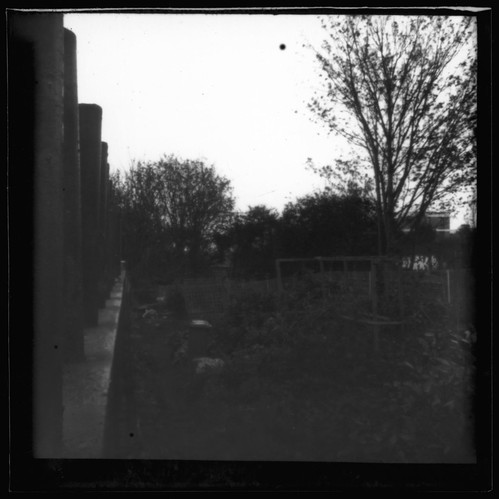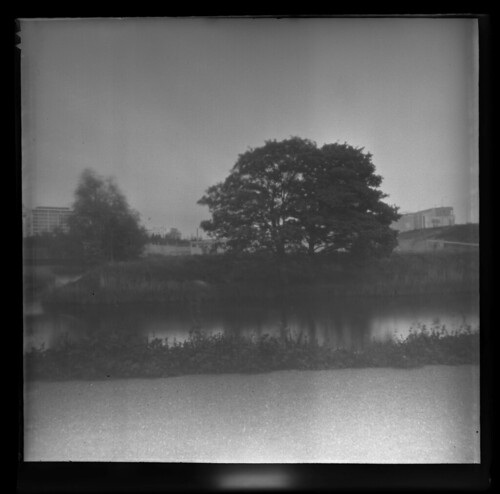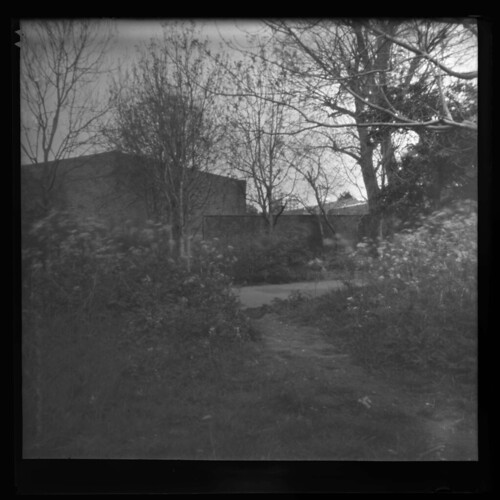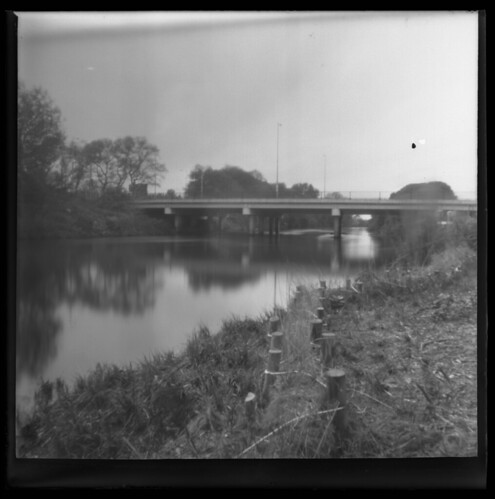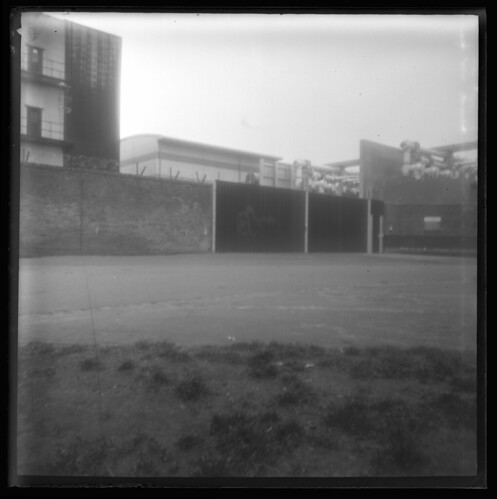Earlier this year when invited to participate in the exhibition
Pinhole and the Art of Invention, I instinctively wanted to turn the premise on its head (“Pinhole and The Art of Invention celebrates the art of invention and the inventiveness of artists by including photographers who build homemade cameras and mechanisms to serve a specific purpose. These innovative apparatuses will take centre stage…”), and, instead of the camera being the inventive mechanism, I wanted to use that invention as a means of showing a sequence of animated pinhole images. For the exhibition, with the pinhole as a constraint, I wanted to use the most minimal means to create a moving image, which meant using pre-cinematic optical devices that produced a form of animated image, specifically the zoetrope, flip book, and phénakisticope. Although commonly thought of as optical toys, these began as instruments to demonstrate theories around the idea of the persistence of vision. Probably the least well-known, the phénakisticope was invented first, and simultaneously, by Joseph Plateau and Simon von Stampfer in 1832 (called the stroboscope by Stampfer), based on work by Peter Mark Roget and Michael Faraday; the zoetrope (in its definitive form), designed by William Ensign Lincoln, and the flip book, by John Barnes Linnett (under the name kineograph), were both invented in the 1860s.
It struck me as a remarkable coincidence that during the same decade that photography was being invented, a number of scientists were independently investigating visual phenomena that could produce the appearance of motion from a sequence of rapidly changing still images. A primitive form of photographic animation would have been theoretically possible from its very birth - although, with the long exposure times then necessary, this would have had to have been constructed through stop motion. The use of the pinhole rather than a lens was simply a consideration in order to fit the remit of the show, but this necessity, and the long exposures that resulted from the pinhole, did provoke the idea that, given the fact that these optical devices were as old as (and separate to) photography, the ‘instantaneous’ photograph (which would become the individual frames of cinema) was not necessary for animation, that the long exposure times of the mid—nineteenth century, replicated in part by the long exposures of the pinhole, could still have created moving images. Yet the desire to do so appears to have only developed after motion had been analytically broken down by the instantaneous photograph, and the subsequent realisation that it could be recombined into movement.
The subject for the animations needed to be simple and repetitive, easy to comprehend and limited to a very few frames. As a model for animated sequences shot with a pinhole camera, I turned to the very beginnings of the moving image, and, specifically, the work of Eadweard Muybridge. Of course, Muybridge didn’t use a pinhole for any of his work, but to animate his photographs, he made a modified version of the phénakisticope, combined with a magic lantern, to project moving images with what he called the
zoöpraxiscope of 1879 (these were generally painted versions, rather than photographic, stretched in order to combat the distortion of the figures caused by the rotation of the disc against the counter-rotation of the viewing slits). I had previously used photographs from Muybridge’s
Animal Locomotion when at college, re-animating some sequences, in my ignorance thinking that in this I was doing something unique, ignorant of those who had done same thing before me; I had also made some flip books using photocopies taken from illustrations in Aaron Scharf’s book,
Art and Photography (where I also encountered the chronophotography of Marey, although Marey is best known for using multiple exposures on a single plate, and so most of his work does not have the ease of Muybridge’s for appropriation, at least for animation). My interest in Muybridge’s work had been rekindled by the Tate Britain exhibition in 2010, which put the
Animal Locomotion in the wider context of his entire career as a photographer.
 |
| Drawings after Muybridge, 1996 |
For the exhibition, I shot sequences based on two plates from
Animal Locomotion, ‘Movement of the hand; drawing a circle’, and ‘Movement of the hand; lifting a ball’, both of which were simple, repetitive motions; the first plate was one that I had used in one of the simple animations I had made while at art college twenty-one years ago. In the original plates, Muybridge constructed his sequences from twelve images, shot from in front of the figure, and a second set from the side; to replicate or emulate these twelve shots on a continuous strip of film, with the 6x6 negative size, a roll of medium format film would provide twelve square shots. I shot the images with an MPP large format camera with a 9x12cm rollfilm back, with a mask for 6x6 negatives. I made a 4x5 to 9x12cm plate back adaptor to use this back, which changed the camera’s film plane, but using a pinhole lensboard, focus was not a consideration. The photographs were shot at a focal length of around 50mm, a wide angle at 6x6, useful as it was difficult to calculate exactly what would be in the frame. For the exhibition itself, I displayed the work in the three forms previously mentioned: my initial idea was to make zoetropes to show the sequences, which were made contact prints from the uncut strip of negatives on Kodak High Resolution Aerial Duplicating film; to these I added phénakistocopes, printed from scans, and also flip books made from contact prints on paper. The latter were the most successful for showing the sequences moving; the luminance of the image does have some bearing on how well the effect of animation was perceived, and the pinhole images I had made were not bright or clear enough for both the zoetropes and phénakistocopes. However, the best representation of these image sequences is as animated GIF files - the perfect form for short, repetitive sequences of images: at one point almost a footnote, an anachronous remnant of the early internet, now social media has made the animated GIF the perfect visual form for the easily digestible meme of the social media age.

That my own hand appears in the frame is a coincidental echo of the
Moebius film made earlier this year, while the theme of emulation or re-enactment also ties it to the
photograph of my hand holding a photograph in Gelsenkirchen as part of
my project around Wim Wenders' locations used in his road movies trilogy in the 1970s. With all of these pieces, projecting oneself into the work, as these were all made on film, taking the photographs entirely myself, there was a difficulty of knowing exactly how much of the image was in view or in focus; someone else could have operated the camera, but it was never practical in these cases. The hand inside the frame stands in for the hand of the viewer; in these two other pieces, the camera placed to suggest a subjective viewpoint, while the pinhole animations attempted the ostensible detachment of Muybridge’s work. The invisible surface of the photograph and its ability to render texture in a close-up image provokes a desire for a tactile confirmation - the viewer wanting to touch - and the hand in the frame provides an imaginative access into this depicted realm. This may be a sublimated response, and only really relates to a certain type of photograph, but perhaps the close-up of any near object has this potential, whether the subject is animate or inanimate, one can imagine the feel of the bark of a tree, the worn surface of steps, the side of a face, a wisp of hair, or in the animations, the textures and responsive pressures of the resistance of a graphite pencil against a sheet of paper. Once made, I had the odd realisation that they (my hands) looked like the hand (or more specifically the forearm) of my father, but reminiscent of the experiences of childhood intimacy, bound up with demonstrations of dexterity - the hands of my father as he demonstrated how to do things: drawing, painting, cutting lino or wood, coupled with the idea that my hands are older now than his were when this would have been the case.

Although Muybridge himself does appear in a number of the
Animal Locomotion plates, the hands in these sequences are not his. They belong to J. Liberty Tadd, the director of the Industrial School of Art in Philadelphia. One wonders if he introduced the idea of the subject of the hand to Muybridge; certainly, the plate of the hand drawing a circle has overt art historical references, most clearly to the anecdote of Giotto drawing a perfect circle freehand, a feat that Albrecht Dürer repeated two centuries later to demonstrate his parity with the artists of the Italian Renaissance. Its circularity is also ideal for the limitations of the twelve-image sequences that Muybridge was working with. Once animated and looped, the circle is infinitely drawn and erased. In my own re-enactment, I marked out twelve positions around a lightly traced circle where my hand would rest for each minute-long exposure, and in doing so made explicit an analogy to the clock, both in the motion and duration of the twelve images. The 'Movement of the hand; lifting a ball' has less immediate associations, although perhaps the clock of the previous plate has now become a globe; these exposures were two minutes long each, and with my hand unsupported for most of the shots, this time duration is more evident in the final pinhole photographs.

The two plates that I drew on for the exhibition were part of a larger sequence of five of Tadd; these five plates all appear at the very end of Part Five of
Animal Locomotion, being ‘Males and Females (Draped)’. All five plates are titled 'Movement of the hand', with the explanatory suffixes: plate 532 is 'Movement of the hand; drawing a circle', 533, 'clasping hands', 534, 'lifting a ball', 535, 'beating time', and 536, 'hands changing pencil' (Part Six which follows is 'Abnormal Movements’). Having re-enacted the first two plates, it seemed logically necessary to tackle the other three plates, to complete the project outside of the exhibition; two of these, clasping hands and hands changing pencil, lack the visual clarity of the other three, in that the representation of a simple gesture or movement does not naturally form a circular unit; one plate in particular, 'Movement of the Hand; beating time', had a richness to it that merited further consideration. Intriguingly, the plate of 'hands changing pencil', although in itself perhaps the least interesting (it appears almost as if it is a preparation for the drawing of the circle - although it is in fact a different tool), in J. Liberty Tadd’s obituary from the American Art News, in its short paragraph, among other achievements, it mentions a demonstration of ‘ambidextral drawing’ to the Royal Arts Society of London in 1891, so this plate might acknowledge Tadd’s ambidextrousness. All five plates of the hand demonstrates
dextrousness of course: the fine motor skills and opposable thumbs of the human hand. That Muybridge’s
Animal Locomotion is in some senses a comparative anatomy, one could infer that evolution might be an implied, unconscious subject.
Plate 535, the 'hand beating time' plate clearly suggests music - and therefore sound. A few of the
Animal Locomotion sequences explicitly do suggest the idea of music in mind of the viewer, namely those of figures dancing; less than a decade after
Animal Locomotion, under the aegis of Thomas Edison, William Kennedy Laurie Dickson’s ‘Experimental Sound Film’ of late 1894 or early 1895 achieved the feat of recording sound and moving images simultaneously, showing Dickson himself playing the fiddle into a phonograph while two men dance. Sound was present from the very birth of cinema, and all through the silent era (the 'silent era' was of course never silent) there were numerous attempts to record sound simultaneously with the images; although the problems with synchronising playback were not conquered until the development of sound-on-film (the earliest successes with ‘talking pictures’ did in fact use sound-on-disc), amplification was as much an issue as synchronicity. I emulated the positions of Tadd’s hand through this sequence rather than beat time itself, given the long exposures. Was Tadd beating time to a tune in his head - or to music provided by one of Muybridge’s assistants? (It would be too fanciful to suggest that he was beating time to music being played on an Edison phonograph; a few short decades later, silent films would use music on set to create an emotional atmosphere for actors - ‘silent’ film sets were themselves notoriously noisy, and in larger, open studios several different scenes might all be being filmed at the same time). Although there is no possibility of reconstructing a tune, Tadd’s hand appears to be beating in triple-time - not itself surprising given the date of the sequence, but I was struck how strongly the visual rhythm suggests this.

Muybridge and Edison met in 1888. Muybridge’s account of the meeting suggests that they discussed using Edison’s phonograph to accompany his zoopraxiscope, although, with the very short duration of Muybridge’s sequences, logically, the phonograph would have needed to simply produce a short loop of sound if these were to be synchronised; the phonograph’s two minutes of recording time must have seemed vastly expansive to Muybridge. The form of the phonograph - a cylinder with a linear, spiral track - informed Edison and Dickson’s initial approach to moving pictures: a glass cylinder with microscopic frames arranged in a spiral. However, after Muybridge, Edison met Marey in 1889, by which time Marey was working with rolls of film rather than fixed plates. Thus Muybridge’s closed, circular motion in the zoopraxiscope led to an open, cylindrical motion, to the linear motion of a continuous strip of film of (theoretically) unlimited length. This was also a transition from the inflexible glass plate to flexible celluloid film (via some experiments with paper) and a host of other inventors (Janssen, Anschütz, Le Prince, Friese-Greene, Donisthorpe, to name a few), as detailed in Rudolf Arnheim’s ‘The Thoughts that Made the Picture Move’.
Muybridge's photographs were cropped significantly for publication in
Animal Locomotion: the frame was imposed retrospectively, and what we see in the neat modernist grids of the published plates is not the whole photograph. The cyanotype contact prints of the photographs that make up the 'Movement of the hand' series show Tadd as a half-length figure, with a hat shading his face against the sun. As with almost all early cinema (and proto-cinema), Muybridge depended on natural light for his sequence images; although the dark, gridded background appears airless, the grid itself was an open screen of twine: in some of the oblique views it's possible to perceive this background as a shallow space beyond the grid that it is possible to enter, not merely the limit of the picture in depth. That the 'Movement of the hand' plates have a unique position in the
Animal Locomotion as a whole is emphasised by the fact that these five plates (as “Class 9. Movements of a man's hand”) were available as one of the separate sections when Muybridge reissued
Animal Locomotion at the time of the 1893 World's Columbian Exposition in Chicago, which had a ‘Zoopraxigraphical Hall’ where he lectured; there is some dispute over whether Edison demonstrated his Kinetoscope at the fair or not. The 'Movement of the hand' plates do not appear to have been translated into zoopraxiscope discs for projection, but one particular aspect of the sequences does foreshadow cinema: they are the only plates which could be said to constitute a
close-up in the whole project. David Campany describes the close-up, along with montage, as part of the distinguishing grammar of cinema, and, that, “…as Beaumont Newhall noted in 1937, ‘photographs of portions of objects (close-ups) were most uncommon before the moving picture.’” This
uncommoness is represented in Muybridge's distinct five plates of the 'Movement of the hand':
The close-up can show us a quality in a gesture of the hand we never noticed before when we saw that hand stroke or strike something, a quality which is often more expressive than any play of the features. The close-up shows your shadow on the wall with which you have lived all your life and which you scarcely knew; it shows the speechless face and fate of the dumb objects that live with you in your room and whose fate is bound up with your own.
Béla Balázs, Theory of the Film
Bibliography
Hans-Christian Adam, Eadweard Muybridge: the Human and Animal Locomotion photographs, Taschen, Köln 2014
Rudolf Arnheim, ‘The Thoughts that Made the Picture Move’, in Film as Art, Faber, London 1958
Béla Balázs, Theory of the film: character and growth of a new art, translated from the Hungarian by Edith Bone, Dover Publications, New York 1970
Philip Brockman, Eadweard Muybridge, Tate, London 2010
David Campany, Photography and Cinema, Reaktion Books, London 2008
Kevin MacDonnell, Eadweard Muybridge: The man who invented the moving picture, Weidenfeld and Nicolson, London 1972
E. J. Marey, Movement, translated by Eric Pritchard, D. Appleton and Co, New York 1895
Eadweard Muybridge, Descriptive Zoopraxography, Lakeside Press, Chicago 1893
Aaron Scharf, Art and Photography, Allen Lane, London 1968
Rebecca Solnit, River of Shadows: Eadweard Muybridge and the Technological Wild West, Bloomsbury, London 2003
Spencer Sundell, The Pre-History of Sound Cinema, Part 1: Thomas Edison and W.K.L. Dickson
J. Liberty Tadd obituary, American Art News






















